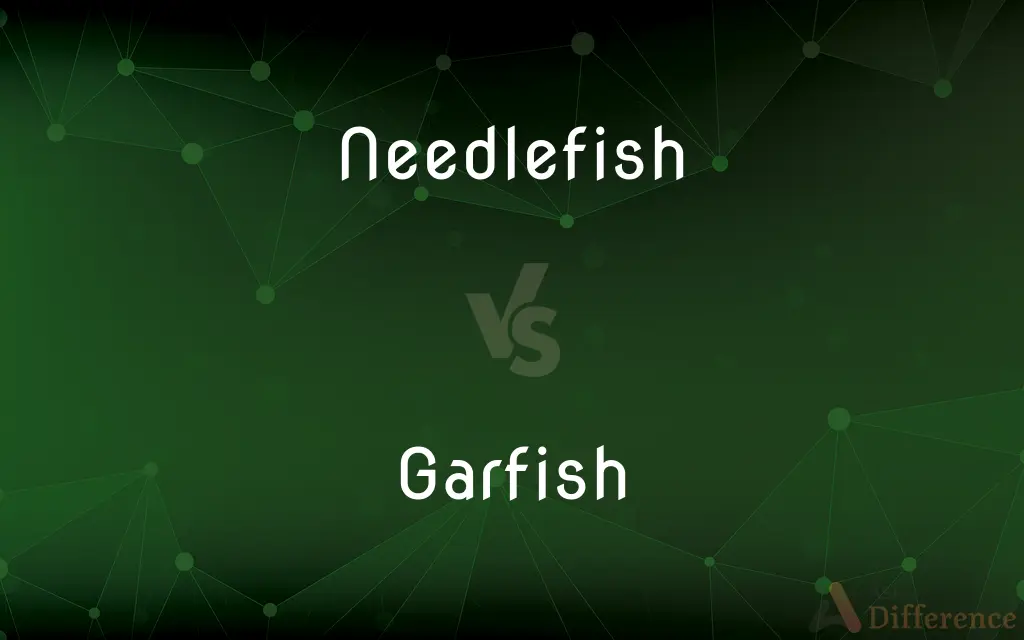Needlefish vs. Garfish — What's the Difference?
By Tayyaba Rehman & Urooj Arif — Updated on March 31, 2024
Needlefish inhabit marine areas with streamlined bodies; garfish, with harder scales, live in freshwater. Both have elongated bodies and sharp-toothed jaws.

Difference Between Needlefish and Garfish
Table of Contents
ADVERTISEMENT
Key Differences
Needlefish are known for their slender, streamlined bodies and long, narrow jaws, making them efficient predators in marine environments. They are surface dwellers, often found in shallow coastal waters or estuaries, and can leap out of the water at high speeds. Whereas garfish, a common term that often refers to members of the gar family (Lepisosteidae), inhabit mostly freshwater environments, including lakes, rivers, and swamps, though some species can venture into brackish waters. Gars have elongated bodies too, but they are distinguished by their ganoid scales, which are hard and diamond-shaped, providing them with extra protection.
The diet of needlefish primarily consists of smaller fish and occasionally crustaceans, which they catch with their sharp teeth during swift attacks. Garfish, on the other hand, have a similar diet but can also include a wider variety of prey due to their habitat diversity, ranging from small fish to aquatic invertebrates. Their method of hunting is also predicated on ambush, using their long bodies to rapidly strike at prey.
Another notable difference is in their reproductive behaviors. Needlefish spawn in shallow waters, laying eggs that attach to vegetation or the sea floor, while gars lay adhesive eggs that stick to underwater vegetation, a trait that helps protect the eggs from being swept away or eaten by predators.
In terms of human interaction, needlefish are sometimes considered a hazard due to their tendency to leap above the water's surface, potentially injuring boaters and swimmers. Gars, with their tough scales and formidable appearance, are often caught for sport, though their flesh is not commonly consumed due to its bony nature. However, in some cultures, gar eggs are considered toxic and should be avoided.
Despite these differences, both needlefish and garfish share adaptations that make them effective predators in their respective environments, including their long, tooth-filled jaws and streamlined bodies, highlighting the diverse strategies of aquatic life in exploiting ecological niches.
ADVERTISEMENT
Comparison Chart
Habitat
Marine and brackish waters
Mostly freshwater, some in brackish waters
Body Covering
Smooth scales
Hard, ganoid scales
Diet
Smaller fish, crustaceans
Small fish, aquatic invertebrates
Reproduction
Eggs attach to vegetation or the sea floor
Adhesive eggs stick to underwater vegetation
Human Interaction
Considered a hazard due to leaping behavior
Caught for sport, flesh not commonly consumed, eggs toxic
Physical Appearance
Streamlined body, long narrow jaws
Elongated body, long snout, diamond-shaped scales
Compare with Definitions
Needlefish
Marine predators with slender bodies.
The needlefish skimmed the surface, hunting for its next meal.
Garfish
Have elongated, toothy snouts.
The gar's snout snapped shut on its unsuspecting prey.
Needlefish
Possess sharp, narrow jaws.
The needlefish caught its prey with its razor-sharp teeth.
Garfish
Freshwater fish with hard scales.
The garfish hid among the reeds, waiting for prey.
Needlefish
Inhabit shallow coastal waters.
Needlefish thrive in the warm, shallow waters near the reef.
Garfish
Known for their bony flesh.
Though not favored by all, garfish can be prepared into a tasty dish.
Needlefish
Known for their leaping ability.
Sailors often see needlefish leaping alongside their boats.
Garfish
Lay adhesive eggs.
Garfish eggs, clinging to the underside of leaves, began to hatch.
Needlefish
Can pose a risk to humans.
A leaping needlefish inadvertently injured a swimmer.
Garfish
Sport fishing favorites.
Anglers respect the garfish for its strength and prehistoric appearance.
Needlefish
Needlefish (family Belonidae) or long toms are piscivorous fishes primarily associated with very shallow marine habitats or the surface of the open sea. Some genera include species found in marine, brackish, and freshwater environments (e.g., Strongylura), while a few genera are confined to freshwater rivers and streams, including Belonion, Potamorrhaphis, and Xenentodon.
Garfish
The garfish (Belone belone), also known as the garpike or sea needle, is a pelagic, oceanodromous needlefish found in brackish and marine waters of the Atlantic Ocean and the Mediterranean, Caribbean, Black, and Baltic Seas.
Needlefish
Any of various marine fishes of the family Belonidae, having slender bodies and long thin jaws with sharp teeth. Also called garfish.
Garfish
See needlefish.
Needlefish
Any of various other slender fishes, such as a pipefish or a sand lance.
Garfish
See gar1.
Needlefish
Slender fish, in the family Belonidae, usually found in shallow marine habitats.
Garfish
Any fish of the needlefish family Belonidae, with a long narrow body and needle-shaped jaws, especially the European species Belone belone.
Needlefish
The European great pipefish (Siphostoma acus or Syngnathus acus); - called also earl, and tanglefish.
Garfish
Any North or Central American fish of the family Lepisosteidae.
Needlefish
Elongate European surface-dwelling predacious fishes with long toothed jaws; abundant in coastal waters
Garfish
A European marine fish (Belone vulgaris); - called also gar, gerrick, greenback, greenbone, gorebill, hornfish, longnose, mackerel guide, sea needle, and sea pike.
Needlefish
Fish with long tubular snout and slim body covered with bony plates
Garfish
Primitive predaceous North American fish covered with hard scales and having long jaws with needle-like teeth
Common Curiosities
How do needlefish and garfish differ in appearance?
Needlefish have streamlined bodies with smooth scales and long, narrow jaws, whereas garfish have elongated bodies covered in hard, ganoid scales, with long snouts that house their sharp teeth.
What environments do needlefish and garfish inhabit?
Needlefish primarily inhabit marine and brackish waters, often near the surface, while garfish, particularly those in the gar family, are found in freshwater environments, with some species also living in brackish waters.
Are needlefish and garfish related?
Despite some similarities in appearance and diet, needlefish and garfish belong to different families and have distinct evolutionary paths, reflecting their adaptation to different ecological niches.
How do needlefish and garfish reproduce?
Needlefish spawn in shallow waters, where their eggs attach to vegetation or the sea floor, whereas garfish lay adhesive eggs that stick to underwater vegetation, ensuring their eggs' safety from predators and currents.
Are garfish eggs safe to eat?
Garfish eggs are considered toxic and should be avoided, in contrast to the edible flesh of the fish itself, which is not commonly consumed due to its bony nature.
Why are needlefish considered a hazard?
Needlefish are considered a hazard because of their tendency to leap out of the water, which can result in injuries to boaters and swimmers.
How are needlefish and garfish viewed in terms of fishing?
Needlefish are less commonly targeted by fishermen due to their leaping behavior and slender bodies, while garfish are often sought after for sport fishing because of their size, strength, and prehistoric appearance, though their flesh is less commonly consumed.
What makes garfish scales unique?
Garfish scales are unique due to their hard, ganoid composition, which provides extra protection against predators and environmental hazards.
What do needlefish and garfish eat?
Both needlefish and garfish are predators that feed on smaller fish, but garfish can also consume a wider variety of aquatic invertebrates due to their diverse freshwater habitats.
Can both needlefish and garfish be found in the same environment?
While it's possible for their habitats to overlap in brackish waters, needlefish are more commonly found in marine environments, and garfish are predominantly freshwater fish, making such occurrences rare.
Share Your Discovery

Previous Comparison
Revelation vs. Prophecy
Next Comparison
Agglutinative vs. PolysyntheticAuthor Spotlight
Written by
Tayyaba RehmanTayyaba Rehman is a distinguished writer, currently serving as a primary contributor to askdifference.com. As a researcher in semantics and etymology, Tayyaba's passion for the complexity of languages and their distinctions has found a perfect home on the platform. Tayyaba delves into the intricacies of language, distinguishing between commonly confused words and phrases, thereby providing clarity for readers worldwide.
Co-written by
Urooj ArifUrooj is a skilled content writer at Ask Difference, known for her exceptional ability to simplify complex topics into engaging and informative content. With a passion for research and a flair for clear, concise writing, she consistently delivers articles that resonate with our diverse audience.














































